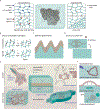Harnessing Mechanobiology for Tissue Engineering
- PMID: 33453155
- PMCID: PMC7855912
- DOI: 10.1016/j.devcel.2020.12.017
Harnessing Mechanobiology for Tissue Engineering
Abstract
A primary challenge in tissue engineering is to recapitulate both the structural and functional features of whole tissues and organs. In vivo, patterning of the body plan and constituent tissues emerges from the carefully orchestrated interactions between the transcriptional programs that give rise to cell types and the mechanical forces that drive the bending, twisting, and extensions critical to morphogenesis. Substantial recent progress in mechanobiology-understanding how mechanics regulate cell behaviors and what cellular machineries are responsible-raises the possibility that one can begin to use these insights to help guide the strategy and design of functional engineered tissues. In this perspective, we review and propose the development of different approaches, from providing appropriate extracellular mechanical cues to interfering with cellular mechanosensing machinery, to aid in controlling cell and tissue structure and function.
Keywords: cytoskeleton and adhesion; mechanical environment; mechanobiology; tissue engineering.
Copyright © 2020 Elsevier Inc. All rights reserved.
Conflict of interest statement
Declaration of Interests The authors declare no competing interests.
Figures


References
-
- Benhardt HA, and Cosgriff-Hernandez EM (2009). The role of mechanical loading in ligament tissue engineering. Tissue Engineering Part B: Reviews 15, 467–475. - PubMed
Publication types
MeSH terms
Grants and funding
LinkOut - more resources
Full Text Sources
Other Literature Sources

